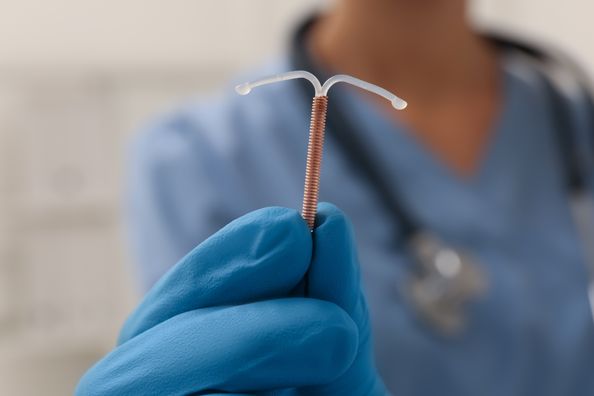Pelvic pain is common, affecting nearly a third of women in the United States, and can be the result of period cramps, endometriosis, uterine fibroids or muscle weakness. When pelvic pain is caused by strain on your pelvic floor muscles, urinary symptoms can also occur. While it may be uncomfortable to discuss pelvic pain and/or urinary symptoms with your obstetrician/gynecologist (OB/GYN), it is important to identify the cause and begin treatment if needed. In some cases, you may be able to reduce symptoms with certain lifestyle modifications. Your OB/GYN may also recommend physical therapy in order to strengthen weakened pelvic floor muscles. Physical Therapy can also help reduce pelvic pain by relaxing over-contracted muscles to provide symptom relief and prevent more serious pelvic health issues from developing.
Most of us have heard the term “pelvic floor”, but may not know what the pelvic floor actually does. Your pelvic floor is a sling-shaped group of muscles that supports your spine, pelvis and reproductive organs including your bladder, colon and rectum. These muscles expand and contract to help stop and start the flow of urine and stool, as well as to promote the passage of gas.
Over time, or during certain activities, your pelvic floor muscles may weaken. In women, this is most common during pregnancy and after childbirth. Women who have had multiple vaginal births, or have birthed babies weighing more than 10 pounds, are at an even higher risk. Other factors can contribute to the weakening of pelvic floor muscles including:
Age
Your pelvic floor muscles naturally weaken as you age.
Constipation
Repeatedly straining to use the bathroom can affect your pelvic floor muscles.
Chronic coughing
If you have lung or breathing difficulties such as asthma, emphysema or recurrent bronchitis, you are at an increased risk.
Genetic factors
Pelvic-related health conditions often run in families.
Heavy lifting
Jobs or hobbies that require frequent heavy lifting can cause pelvic and back strain, weakening your pelvic floor muscles over time.
High-impact exercise
Regularly engaging in high-impact activities, including basketball or running, can increase your risk.
Weight
Being overweight or obese, especially carrying extra weight in your abdomen, can strain your pelvic floor muscles.
Signs that your pelvic floor muscles may need strengthening include:A feeling of heaviness or pressure in your pelvic area
- Lack of bladder and/or bowel control
- Urinary leakage with physical exertion or during activities such as coughing, sneezing and laughing
- Increased frequency and/or urgency to urinate
If you are experiencing pelvic floor-related symptoms, your OB/GYN can help you develop a treatment plan to strengthen your pelvic floor muscles and address any associated symptoms. Certain lifestyle modifications may reduce your risk and provide symptom relief including:
- Avoiding heavy lifting
- Consuming adequate amounts of fluids and fiber each day to address chronic constipation
- Eating a balanced diet to help maintain a healthy weight and support healthy bowel habits
- Emptying your bladder regularly (try to use the bathroom every two to four hours)
- Exercising regularly
- Not smoking as it leads to respiratory issues including chronic coughing
- Limiting your intake of alcohol and caffeine
- Strengthening your pelvic floor muscles with Kegel exercises
Additionally, your OB/GYN may recommend physical therapy to learn exercises and techniques you can use to strengthen your pelvic floor and surrounding muscles. It is important to keep your pelvic floor strong in order to prevent conditions such as urinary incontinence and pelvic organ prolapse (POP) from developing. Specially trained women’s health physical therapists are available at DuPage Medical Group to help you improve the flexibility and coordination of these muscles, providing better stability in your pelvic floor. They offer several pelvic health services including:
Posture and child care techniques
Being mindful of your posture, and learning how to engage and utilize your neutral spine, can help minimize (or prevent) pelvic and back pain. Pay attention to your posture when performing certain activities such as pushing a stroller, carrying a car seat and getting out of bed. Your therapist can recommend ways to reduce discomfort with activity modifications like using a backpack instead of a diaper bag or placing an infant tub in a sink or on a counter.
Strengthening your core
Diastasis Recti (DrA) affects almost two-thirds of women during pregnancy and nearly 60 percent of women after childbirth. DrA develops when the space between your right and left stomach muscles widen. The additional pressure in your abdomen while pregnant makes it difficult for your abdominal muscles to keep their shape and the lack of support causes your stomach to stick out. Symptoms of DrA include abdominal and lower back pain, constipation, incontinence and pain during intercourse. Your physical therapist can help you strengthen certain muscles within your core with breathing techniques combined with ways to activate your pelvic floor muscles, as well as the muscles responsible for your core and hip stability. In some cases, these techniques may not resolve DrA symptoms and surgery may be required.
Pelvic floor exercises
Kegel exercises and other support techniques are often an effective way to strengthen the muscles in your pelvic floor. Your therapist will instruct you on how to perform each exercise correctly so that you can do them on your own at home.
In some women, especially if left untreated, a weakened pelvic floor can lead to other pelvic and urinary conditions, most commonly stress-related urinary incontinence and pelvic organ prolapse (POP).
Stress-related urinary incontinence
Stress incontinence is common during pregnancy and after childbirth. Nearly 50 percent of women will experience stress incontinence during their pregnancy. Of those women, a third will continue to experience incontinence symptoms after giving birth. This is because of the elevated hormones and weight gain that occurs during pregnancy which places increased pressure on pelvic floor muscles, as well as the stretching in the pelvic area that happens during labor.
Pelvic Organ Prolapse (POP)
POP can develop when the muscles and ligaments that support your pelvic organs weaken, allowing them to slip out of their natural position. Signs of POP include:
- Pressure in the vaginal area
- A visible bulge or protrusion
- Difficulty urinating or defecating
In some cases, despite conservative treatment and lifestyle modifications, your symptoms may persist or worsen. To address ongoing pelvic health concerns, your OB/GYN can refer you to a urologist who specializes in pelvic health conditions. Additional treatment options can include pessary (a soft, flexible device that is placed inside the vagina to assist in supporting pelvic organs) and surgery. Your OB/GYN, therapist and urologist will work together to help you establish a treatment plan that is right for you.
To discuss your pelvic health and any symptoms you may be experiencing, schedule an appointment with an OB/GYN online or by calling your preferred location.
Health Topics:







